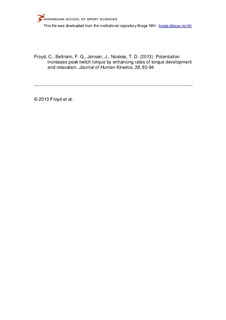| dc.contributor.author | Froyd, Christian | |
| dc.contributor.author | Beltrami, Fernando Gabe | |
| dc.contributor.author | Jensen, Jørgen | |
| dc.contributor.author | Noakes, Timothy David | |
| dc.date.accessioned | 2014-01-14T10:32:59Z | |
| dc.date.available | 2014-01-14T10:32:59Z | |
| dc.date.issued | 2013 | |
| dc.identifier | Seksjon for fysisk prestasjonsevne / Department of Physical Performance | |
| dc.identifier.citation | Journal of Human Kinetics. 2013, 38, 83-94 | no_NO |
| dc.identifier.uri | http://hdl.handle.net/11250/171230 | |
| dc.description | © Editorial Committee of Journal of Human Kinetics | no_NO |
| dc.description.abstract | The aim of this study was to measure the extent to which potentiation changes in response to an isometric maximal voluntary contraction. Eleven physically active subjects participated in two separate studies. Single stimulus of electrical stimulation of the femoral nerve was used to measure torque at rest in unpotentiated quadriceps muscles (study 1 and 2), and potentiated quadriceps muscles torque in a 10 min period after a 5 s isometric maximal voluntary contraction of the quadriceps muscles (study 1). Additionally, potentiated quadriceps muscles torque was measured every min after a further 10 maximal voluntary contractions repeated every min (study 2). Electrical stimulation repeated several times without previous maximal voluntary contraction showed similar peak twitch torque. Peak twitch torque 4 s after a 5 s maximal voluntary contraction increased by 45±13% (study 1) and by 56±10% (study 2), the rate of torque development by 53±13% and 82±29%, and the rate of relaxation by 50±17% and 59±22%, respectively, but potentiation was lost already two min after a 5 s maximal voluntary contraction. There was a tendency for peak twitch torque to increase for the first five repeated maximal voluntary contractions, suggesting increased potentiation with additional maximal voluntary contractions. Correlations for peak twitch torque vs the rate of torque development and for the rate of relaxation were r2= 0.94 and r2=0.97. The correlation between peak twitch torque, the rate of torque development and the rate of relaxation suggests that potentiation is due to instantaneous changes in skeletal muscle contractility and relaxation. | no_NO |
| dc.language.iso | eng | no_NO |
| dc.publisher | Versita | no_NO |
| dc.subject | maximal isometric voluntary contraction | no_NO |
| dc.subject | quadriceps muscles | no_NO |
| dc.subject | electrical stimulation | no_NO |
| dc.subject | decay | no_NO |
| dc.subject | fatigue | no_NO |
| dc.title | Potentiation increases peak twitch torque by enhancing rates of torque development and relaxation | no_NO |
| dc.type | Journal article | no_NO |
| dc.type | Peer reviewed | no_NO |
| dc.subject.nsi | VDP::Medical disciplines: 700::Sports medicine: 850::Exercise techniques: 851 | no_NO |
| dc.source.journal | The Journal of Human Kinetics | no_NO |
| dc.identifier.doi | 10.2478/hukin-2013-0048 | |
